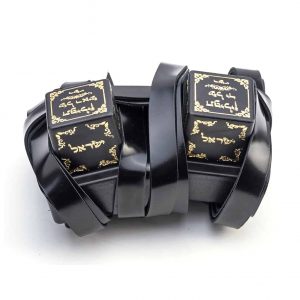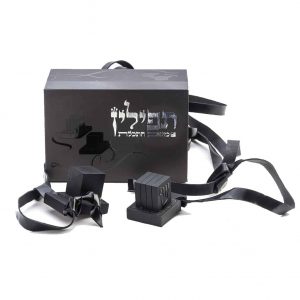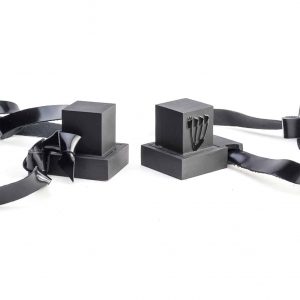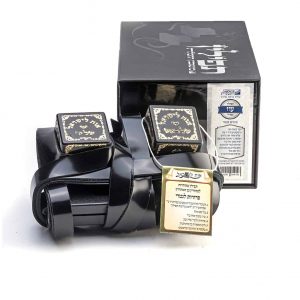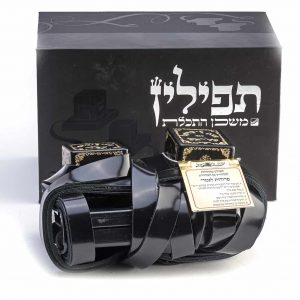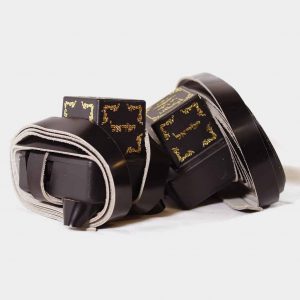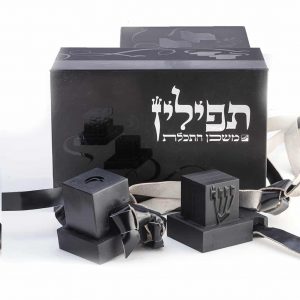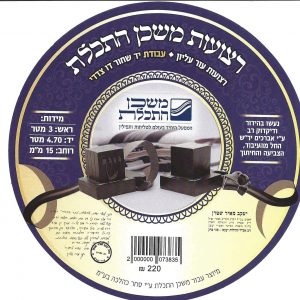No products in the cart.
Kosher Tefillin
-
Tefillin (from large cattle) – “HOD” ⋆ Mehudar A [Ari/Chabad font]
Tefilin “HOD” – Ktav Ari/Chabad/the alter rebbe
1) Teffilin houses made from Behema gasa (cow’s leather)
2) Goes on the left hand (meant for right handed)
3) Rov Peroodot
4) Shin Meshoocha all by hand
5) Parshiot mehoodarot
6) Miksha beit
7) black straps on both sides$746.00 – $756.00 -
Tefillin (from large cattle) – “HOD” ⋆ Mehudar A [Ashkenazi]
Tefilin “HOD” – Ashkenazi
1) Teffilin houses made from Behema gasa (cow’s leather)
2) Goes on the left hand (meant for right handed)
3) Rov Peroodot
4) Shin Meshoocha all by hand
5) Parshiot mehoodarot
6) Miksha beit
7) black straps on both sides$746.00 – $756.00 -
Tefillin (from large cattle) – “HOD” ⋆ Mehudar A [Sephardic]
Tefilin “HOD” – Sephardic
1) Teffilin houses made from Behema gasa (cow’s leather)
2) Goes on the left hand (meant for right handed)
3) Rov Peroodot
4) Shin Meshoocha all by hand
5) Parshiot mehoodarot
6) Miksha beit
7) black straps on both sides$706.00 -
Tefillin (from large cattle) – “OZ” ⋆ Mehudar AA [Ashkenazi]
Tefillin “OZ”- Gassot – Ktav Ashkenazi
1) made by Miskan Hatchelet
2) Tefillin houses made from behema gasa (cow’s skin)
3) miksha beit
4) peroodot legamre
5) shin mashooach all by hand
6) parshiot mehoodarot AA
7) sewing thread from Tefiilin house to the other without aperture
8) leather straps, black on both sides (“crow”)
$869.00 – $879.00 -
Tefillin (from large cattle) – “OZ” ⋆ Mehudar AA [Ktav Ari/Chabad]
Tefillin “OZ”- Gassot – Ktav Ari/Chabad/the alter rebbe
1) made by Miskan Hatchelet
2) Tefillin houses made from behema gasa (cow’s skin)
3) miksha beit
4) peroodot legamre
5) shin mashooach all by hand
6) parshiot mehoodarot AA
7) sewing thread from Tefiilin house to the other without aperture
8) leather straps, black on both sides (“crow”)
$869.00 -
Tefillin (from large cattle) – “OZ” ⋆ Mehudar AA [Sephardic]
Tefillin “OZ”- Gassot – Ktav Sephardic
1) made by Miskan Hatchelet
2) Tefillin houses made from behema gasa (cow’s skin)
3) miksha beit
4) peroodot legamre
5) shin mashooach all by hand
6) parshiot mehoodarot AA
7) sewing thread from Tefiilin house to the other without aperture
8) leather straps, black on both sides (“crow”)
$814.00 -
Tefillin (from large cattle) – “Pe’er” ⋆ Mehudar AAA [Ashkenazi]
Tefillin “Peer” Ashkenazi– 8 hidoorim- behema gasa -peroodot legamre – ribooa regel – no glue
1) made by Miskan Hatchelet
2) Tefillin houses made from behema gasa (cow’s skin)
3) miksha beit
4) peroodot legamre
5) shin mashooach all by hand
6) parshiot mehoodarot AA
7) sewing thread from Tefiilin house to the other without aperture
8) leather straps, black on both sides (“crow”)
9) ribboa regel
10) sewing leshem mitzvat Tefiilin
$1,059.00 -
Tefillin (from large cattle) – “Pe’er” ⋆ Mehudar AAA [Ktav Ari/Chabad]
Tefillin “Peer” Ktav Ari/Chabad/the alter rebbe– 8 hidoorim- behema gasa -peroodot legamre – ribooa regel – no glue
1) made by Miskan Hatchelet
2) Tefillin houses made from behema gasa (cow’s skin)
3) miksha beit
4) peroodot legamre
5) shin mashooach all by hand
6) parshiot mehoodarot AA
7) sewing thread from Tefiilin house to the other without aperture
8) leather straps, black on both sides (“crow”)
9) ribboa regel
10) sewing leshem mitzvat Tefiilin
$1,059.00 -
Tefillin (large cattle) – “Pe’er” ⋆ Mehudar AAA [Sephardic]
Tefillin “Peer” Sephardic – 8 hidoorim- behema gasa -peroodot legamre – ribooa regel – no glue
1) made by Miskan Hatchelet
2) Tefillin houses made from behema gasa (cow’s skin)
3) miksha beit
4) peroodot legamre
5) shin mashooach all by hand
6) parshiot mehoodarot AA
7) sewing thread from Tefiilin house to the other without aperture
8) leather straps, black on both sides (“crow”)
9) ribboa regel
10) sewing leshem mitzvat Tefiilin
$1,406.00 – $1,506.00 -
Tefillin Dakkot “Noy” ⋆ Peshutim Mehudarim [Ari/Chabad]
Tefillin “Noy” – behema daka – Ktav Ari/Chabad/the alter rebbe
1) Made by Miskan Hatchelet
2) Peshootim Mehoodarim
3) Shin mashooach from within the Tefillin house, connected with “wings”
4) Tefillin houses made from behema daka (sheep/goat’s skin)
5) handmade straps, black on both sides
6) Parshiot ksherot le’chatcheela
7) machine made straps (black from one side)
$386.00 – $387.00 -
Tefillin Dakkot “Noy” ⋆ Peshutim Mehudarim [Ashkenazi]
Tefillin “Noy” – behema daka – Ashkenazi
1) Made by Miskan Hatchelet
2) Peshootim Mehoodarim
3) Shin mashooach from within the Tefillin house, connected with “wings”
4) Tefillin houses made from behema daka (sheep/goat’s skin)
5) handmade straps, black on both sides
6) Parshiot ksherot le’chatcheela
7) machine made straps (black from one side)
$386.00 -
Tefillin Dakkot “Noy” ⋆ Peshutim Mehudarim [Sephardic]
Tefillin “Noy” – behema daka – Sephardic
1) Made by Miskan Hatchelet
2) Peshootim Mehoodarim
3) Shin mashooach from within the Tefillin house, connected with “wings”
4) Tefillin houses made from behema daka (sheep/goat’s skin)
5) handmade straps, black on both sides
6) Parshiot ksherot le’chatcheela
7) machine made straps (black from one side)
$366.00 -
Tefillin Handmade straps set – black on both two sides
Size of the straps A total of 7.7 meters – of which: a 4.7-meter hand strap and a 3-meter-long head-band, the thickness of the straps 15 mm.
$74.00$81.00
Tefillin Our connection to Hashem
The Tefillin Written and proofread by a God-fearing Scribes
Tefillin are a set of black leather boxes that contain Hebrew parchment scrolls. Jewish men wear it on their arm and head during weekday morning prayer. A set of Tefillin includes the box, the strap, and the scrolls. Tefillin are among the most powerful mitzvahs in the Torah. It reminds the wearer that they should harness their actions, intellect, and emotions to the service of G‑d.
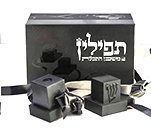
Tefillin are available in different sizes. Prices can vary significantly based on differences in quality. Tefillin are divided into three different categories based on the quality of the leather boxes. The simplest Tefillin are called Peshutim. It’s made from two pieces of leather.
Those that are made from a thick piece of leather are known as Tefillin Gassot. This is the most expensive and durable type of Tefillin. You can also find a pair that is made from a thin piece of leather. It is called Tefillin Dakkot.
Male Jews after the age of 13 years have to lay a pair of Tefillin. Although women are usually exempted from the duty, some early codifiers allowed them, women, to do it as well. Some females kept the ceremony in medieval Germany and France. Today, both men and women choose to wear a pair of Tefillin. Wearing of Tefillin remains a male-only responsibility in the Orthodox movement. In egalitarian movements, women may do it as an obligation. For instance, girls in SAR High School are allowed to wrap Tefillin during morning prayers or Shacharit.
There are some exemptions as well. Those suffering from stomach-trouble or in pain and can’t focus their mind is exempt from wrapping Tefillin. A bridegroom on his wedding-day and mourners during the first day of their mourning period are also exempt. Those who are studying Law, as well as dealers and scribes of Tefillin, are exempt too if their work can’t be postponed.
About the mitzvah of Tefillin
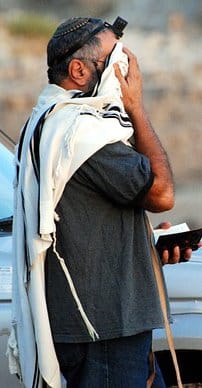
This mitzvah is said to be equivalent to the whole Torah and is one of the three mitzvot which constitute an “OT” – a sign. A Sign of the special connection between the Jewish people and God. (The other two mitzvahs that are considered a “sign” are circumcision and Shabbat).
The first encounter with tefillin takes place by the age of 13, the bar mitzvah, unlike other mitzvot which taught to children from an early age. According to Jewish law, this mitzvah takes place during the daytime and not at night, on a weekday and not on Shabbat and holidays, when women are exempt from having to participate in this mitzvah.
What is Tefillin?
Tefillin is made out of two black leather boxes, containing a leather sheet, on which are written four passages from the Torah (also called “the four parshiot”). There are two main methods regarding the order of the parshiot in it – the Rashi method and the Rabbeinu Tam method. Most people buy Rashi ones. Each of the leather boxes containing the four parshiot connected to black leather straps. This mitzvah divided into two parts: The part of the hand (shel yad) and The part of the head (shel Rosh).
How to put on Tefillin?
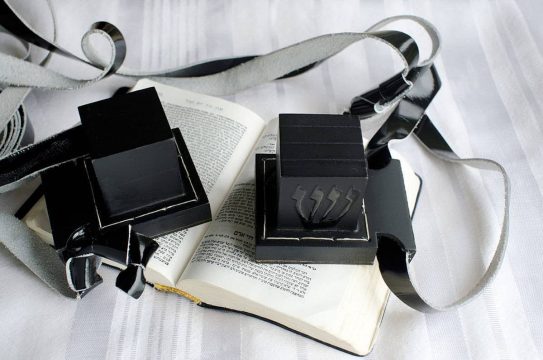 First, wear the tefillin of the hand (shel yad) and then the tefillin of the head (shel Rosh). The hand tefillin are placed on the weak hand – usually the left hand. If a person is right-handed, he will put it on his left arm, and if he is left-handed, he will place the tefillin on his right arm. (a left-handed person needs to pay attention when buying a Tefillin that it indeed meant for left-handed people.
First, wear the tefillin of the hand (shel yad) and then the tefillin of the head (shel Rosh). The hand tefillin are placed on the weak hand – usually the left hand. If a person is right-handed, he will put it on his left arm, and if he is left-handed, he will place the tefillin on his right arm. (a left-handed person needs to pay attention when buying a Tefillin that it indeed meant for left-handed people.
It usually is mentioned in the product description). The head tefillin must be placed just ABOVE the natural hairline, precisely in the middle. After you put them on your arm, and before you tie the straps, you should say the blessing of putting on Tefillin. Immediately after placing the part of the hand, the part of the head should be set without interruption between them. When you say the blessing, also aim for the head part (shel Rosh).
Why are they painted black?
The answer can found in the verses of Shema Yisrael, one of the central prayers recited during tefillin. At Shma Yisroel we proclaim that the Creator of the world is the One and Only: The Lord our God is One! The leather sheet inside the tefillin boxes also contains the verses of the Shema. Black color has a unique feature: it is absolute. Other colors cannot overcome it. This unique trait of black color symbolizes the perfect unity of God, a complete and total unity.
From the words of the Lubavitcher Rebbe about the tefillin
“In the midst of every human being there is a constant struggle between reason and emotion, and when the mind becomes powerless, and emotion dominates without straining, the results will be tragic. The tefillin of the head are worn on the head, the seat of the intellect, while those of the hand are placed on the left hand, facing the heart. The message: to harness the mind and emotion together with their main place of residence – the arm and the head – to the work of the Creator. “
How Are Tefillin Made?
There are hundreds of detailed rules that govern the manufacturing processes of the parchment scrolls and the boxes. The Tefillin were either cubical or cylindrical in the earlier Talmudic times, but the cylindrical form became outdated later on. Today, the boxes should be made from one piece of animal hide that is kosher and creates a base with an upper box to contain the scrolls. These boxes are made at different quality levels.
What’s in the Boxes?
The Torah makes four separate mentions of the mitzvah of tefillin. Each text placed on parchment, which then put into the tefillin. The passages all focus on the unity of God. They contain descriptions of the miracles God performed upon taking us out of Egypt.
They also discuss the fact that only God can do whatever He wants in both the physical and spiritual worlds. These texts are:
- Kadesh (Exodus 13:1-10) – This covers the Jewish peoples’ duty never to forget the removal from Egyptian bondage. It also includes the responsibility of Jews to educate their children about the same, as well as the commandments.
- Vehaya ki yeviacha (Exodus 13: 11-16) – This text is like the Kadesh.
- Shema (Deut. 6:4-9) – Details God’s unity and instructs us to fear and love Him.
- Vehaya (Deut. 11:13-21) – Covers God’s assurance of rewards for following the Torah’s mitzvahs.
Who Wears Tefillin?
Tefillin are worn by every Jewish male who is over the bar mitzvah age (13 years old).
When Are Tefillin Worn?
The mitzvah fulfilled once the tefillin put on between sunrise and nightfall. A Shema prayer reading is customary, and a blessing also recited. Traditionally, tefillin are worn along with morning prayers on weekdays. During Shabbat and major Jewish holidays such as Chol HaMoed, tefillin are not worn.

